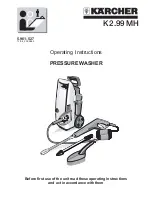
MAINTENANCE /
REP
AIR
TROUBLESHOOTING
OPERA
TION
ASSEMBL
Y /
INST
ALLA
TION
SAFETY /
SPECIFICA
TIONS
GETTING ST
AR
TED
12
OPERATING INSTRUCTIONS (CONTINUED)
Changing Nozzles on Spray Wand (Fig. 20)
Risk of fluid injection. Do not direct discharge stream toward persons,
unprotected skin, eyes or any pets or animals. Serious injury will occur.
Flying objects could cause risk of serious injury. Do not attempt to change
nozzles while pressure washer is running. Turn engine off before
changing nozzles.
1. Pull quick-connect coupler (E) back and insert nozzle (K).
2. Release quick-connect coupler and twist nozzle to make sure it is secure in coupler.
Flying object could cause risk of serious injury. Ensure nozzle is completely inserted in quick-
connect socket and quick-connect collar is fully engaged (forward) before squeezing gun trigger.
How To Apply Chemicals/Cleaning Solvents (Fig. 21)
Applying chemicals or cleaning solvents is a low pressure operation.
NOTE:
Use only
soaps and chemicals designed for pressure washer use. Do not use bleach.
TO APPLY CHEMICALS:
1. Ensure detergent siphon hose (Figure 21) is attached to barbed fitting location
near high pressure hose connection of pump as shown.
2. Place other end of detergent siphon hose with filter on it into container holding
chemical/cleaning solution.
NOTE:
For every 7 gallons of water pumped 1 gallon of
chemical/cleaning solution will be used.
3. Install low pressure (black) nozzle into quick connect fitting of spray wand, see How To Use Spray Wand
paragraph in this section.
4. After use of chemicals, place detergent siphon hose into container of clean water and draw clean water
through chemical injection system to rinse system thoroughly. If chemicals remain in the pump, it could
be damaged. Pumps damaged due to chemical residue will not be covered under warranty.
NOTE:
Chemicals and soaps will not siphon if the soap nozzle is not selected on the spray wand.
Starting (Fig. 22)
To reduce the risk of injury, read the pressure washer instruction manual and the engine
instruction manual before starting pressure washer.
Risk of fluid injection and laceration. When using the high pressure setting, DO NOT allow the
high pressure spray to come in contact with unprotected skin, eyes, or with any pets or animals.
Serious injury will occur.
•
Your washer operates at fluid pressures and velocities high enough to penetrate human and animal
flesh, which could result in amputation or other serious injury. Leaks caused by loose fittings or worn or
damaged hoses can result in injection injuries. DO NOT TREAT FLUID INJECTION AS A SIMPLE CUT! See a
physician immediately!
Carbon Monoxide. Using an engine indoors can kill you in minutes. Engine exhaust contains
high levels of carbon monoxide (CO), a poisonous gas you cannot see or smell. You may be
breathing CO even if you do not smell engine exhaust.
•
Breathing ex haust fumes will cause se ri ous injury or death! En gine exhaust contains carbon mon ox ide,
an odorless and deadly gas.
•
Operate pressure washer in a well-ventilated area. Avoid en closed areas such as ga rages, base ments,
etc.
•
Never op er ate unit in or near a lo ca tion occupied by humans or animals.
Risk of Fire, Asphyxiation and Burn. Never fill fuel tank when engine is running or hot. Do not
smoke when filling fuel tank.
•
Never fill fuel tank completely. Fill tank to 1/2” (12.7 mm) below bottom of filler neck to provide space
for fuel expansion. Wipe any fuel spillage from engine and equipment before starting engine.
•
DO NOT let hoses come in contact with very hot engine muffler during or immediately after use of
your pressure washer. Damage to hoses from contact with hot engine surfaces will NOT be covered by
warranty.
K
E
F
Figure 20
Figure 21















































